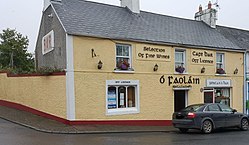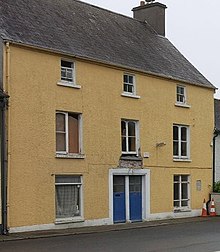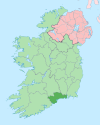Village in Munster, Ireland
| Stradbally An tSráidbhaile (Irish) | |
|---|---|
| Village | |
 Pub in Stradbally Pub in Stradbally | |
 | |
| Coordinates: 52°07′48″N 7°27′36″W / 52.13000°N 7.46000°W / 52.13000; -7.46000 | |
| Country | Ireland |
| Province | Munster |
| County | County Waterford |
| Population | 438 |
| Time zone | UTC+0 (WET) |
| • Summer (DST) | UTC-1 (IST (WEST)) |
Stradbally (from Irish An tSráidbhaile, meaning 'the (one) street town', IPA:) is a small village in County Waterford, Ireland. The village is in a civil parish of the same name.
History
Medieval period
In 1215, King John granted the custody of the counties of Waterford and Desmond (most of Cork and Kerry) to Thomas fitz Anthony. This was a reward for fitz Anthony's support for the king in fighting rebel barons in England at the time. Thomas fitz Anthony seems to have founded the medieval town of Stradbally, which was situated at the centre of his lordship (he also founded Thomastown in County Kilkenny). Thomas fitz Anthony died in 1226 or 1227 and the lordship subsequently passed to one of his sons-in-law, Thomas de Dene. When Thomas de Dene's son Reginald died in 1302, he held a quarter of the town of Stradbally from the king. Stradbally subsequently passed to a branch of the FitzGeralds, Earls of Desmond, who held it until the early 18th century. In 1300, when King Edward I levied his Irish domains to finance his war against Scotland, Stradbally was one of five towns in the county to be assessed for special payments. It is also known that Stradbally had a mill, as there are references to it in 1298 and 1336, but its location is not known. All this suggests that Stradbally was an important medieval town. All that remains of medieval Stradbally, however, is its church; it is not known what became of the rest of the town. In 1654 the Civil Survey described Stradbally as ‘a County Towne with a greate many howses’, which suggests that the medieval settlement had survived in some form up until then.
18th and 19th centuries
The present village of Stradbally dates from around the end of the 18th century, and was built by the Uniacke family of Woodhouse, who owned the village and most of the surrounding district. At the centre of the village is a market square surrounded by terraces of two-storey houses and businesses. The three-storey building which dominates the east side of the square is a former police barracks, and is probably slightly older than the buildings around it.
Stradbally has two churches. St James’ Church of Ireland church is located at the top of Church Lane, just behind the ruined medieval church. Work on this church began with the appointment of John Devereux as Vicar of Stradbally in 1798. The main body of the church was completed in 1802, with the addition of a tower four years later. The tower was originally topped with a spire, but this was removed in 1876 when the chancel was added. The church also had a gallery, accessed from the first floor of the belfry, but this is also long since gone. The church was dedicated to St James in 1970. It is typical of the numerous Church of Ireland churches built by the Board of First Fruits in the late 18th and early 19th centuries. The Board was an institution of the Church of Ireland that was established in 1711 by Queen Anne to build and improve churches in Ireland. Holy Cross Catholic church is located a short distance outside the village. A map from 1819 shows a church just south of where the present church now stands. The present church, a large, single-cell, barn-type structure, was built in 1834. Stained glass windows were added in 1868, followed by an imposing tower in 1870 and an apse in 1873. These additions were largely funded by the Barron family.
The Sisters of Mercy came to Stradbally in 1875 at the invitation of the parish priest, Fr Thomas Casey. Initially they lived in Myrtle Lodge (adjacent to the Old Rectory, and which itself had served as a rectory earlier in the century), then in 1883 they moved into what had been Hannigan's Hotel in the square (now Whelan's pub). When Fr Casey died in 1885, the sisters moved into the former parochial house behind Holy Cross Church, renaming it Mount St Joseph's. They also built a school in the grounds, which opened in 1890. In addition to this the sisters established a small linen industry to give employment to local girls. The industry was successful and lasted for over thirty years, but mass production and cheap imports led to its closure in 1925. Dwindling vocations led to the convent's closure in 1988.
The school established by the sisters was not the only one in the village. A Church of Ireland primary school was built by the Uniacke family of Woodhouse around the beginning of the 19th century, opposite the Church of Ireland church. In 1819, the school was kept by the curate, who taught 'English, Greek and Latin, at £30 per annum for boarders, and four guineas for day boys'. The school has opened and shut several times, depending on numbers, but it continues in use to this day as St James’ National School. In 1806, local Catholic landowner Pierce Barron opened a school ‘for the gratuitous education of the poor of the parish’. The building was divided in two – boys were taught at one end and girls at the other. The building functioned as a boys' school until 1966 when the new boys’ school opened nearby. The Barron School was repurposed as a community hall, and has been extensively restored in recent years.
20th century
See also: Disappearance of Larry Griffin
Stradbally GAA club was founded in 1886. Gaelic football is the dominant sport in the parish, with the Stradbally team winning five-in-a-row senior county football titles from 1940 to 1944 and again from 2001 to 2005. Gaelic games were played in a variety of locations in the district, before the club acquired a permanent pitch in the early 1970s. A clubhouse was built in 1979. The GAA ground is named after local priest Fr Pat Cummins, who trained the Stradbally team in the early 1940s. There is also a handball alley on the Chapel Road, built in 1934.
On Christmas Day 1929, local postman Larry Griffin disappeared from the village. Several residents were arrested and charged but the case fell apart and all were acquitted.
Built heritage
Medieval church
Stradbally's ruined medieval church is situated beside the present Church of Ireland church. A large building, it comprises three sections – the nave, the chancel and the tower. The oldest (c.1215) and largest part of the church is the nave, rectangular in shape and over 17 metres long. It consists of two doorways, one each in the north and south walls. Either side of the north doorway are draw-bar sockets, for securing the door on the inside; in times of danger, the bar was drawn across and reinforced the door. Just inside the south doorway is a stoup or font for holy water, carved out of a single block of sandstone. The west gable was once surmounted by a bell-cot (a small shelter for the church bell), which was still there when John O’Donovan from the Ordnance Survey visited in 1841. This has now gone, but the remains of a small window can still be seen. Originally there would have been an arch connecting the nave with the chancel, but this is also now gone. The present chancel is a post-medieval rebuild. In the sanctuary, against the east gable, is the burial place of the Powers of Ballyvoile – the inscription on the gravestone outlines their genealogy in detail, although doubt has been cast on elements of it.
The tower probably dates from the 13th or 14th century, and consisted of three storeys. What now remains of the tower is the north half; the south half may have collapsed into the original chancel, necessitating the reconstruction of same. It is not quite clear how one actually entered the tower, but possibly there was a doorway in the north wall of the chancel. In the surviving north portion of the tower are the remains of a spiral staircase and a garderobe or toilet. The tower probably served as a residence for the priest.
Perhaps due to its spacious interior, the church has often been mistaken for an Augustinian abbey. This belief probably stems from the fact that for over 300 years, the church was in the possession of the Augustinian Priory of Inistioge which, like Stradbally, was founded by Thomas fitz Anthony. In 1540, at the height of the Reformation, the church and rectory of Stradbally were taken over by the Crown, and came under the control of the Bishop of Lismore. It is not known how long the church remained open after this. In 1615 it was described as being in a dilapidated state. The oldest dated gravestone is that of Michael Martin who died in 1717, which suggests that the church was almost certainly in ruins by that time. The gravestone is adorned with a skull and crossbones, a common symbol of mortality at the time.
The most unusual feature of the ruined church is not the church itself but an inscribed gravestone which lies prone in the corner of the nave. Around the edge of the stone is an inscription, the surviving portion of which reads: ‘YSABELLA GAL… JACET PLNI’. The top of the stone is covered in a variety of symbols, most of which seem to have some Christian significance, including the lily (symbolising the Resurrection) and the all-seeing eye, though this is a matter of interpretation. The stone is a mystery, and it is not known how it ended up in the church, but it probably dates from around 1600, when the church was possibly still in use. The identity of "Ysabella" is not known either. It has been speculated that she was a Galvin or Galwey, both of which are local names. Indeed, one 19th-century scholar thought that the stone had nothing to do with anyone named Ysabella, and suggested – improbably – that if the inscription was complete, it would read: 'Beneath this altar lie the remains of Blessed Paulinus'.
References
- "Sapmap Area: Settlements Stradbally". Census 2016. Central Statistics Office. Retrieved 7 January 2022.
- ^ "An tSráidbhaile/Stradbally". Placenames Database of Ireland. Archived from the original on 9 July 2018. Retrieved 7 February 2018.
- "Stradbally". Archived from the original on 9 July 2018. Retrieved 8 July 2018.
- ^ Flaherty, Cian (2018). "Stradbally: a picturesque 18th-century village with medieval roots". In Willie Whelan (ed.). The towns and villages of the Waterford Greenway. Waterford County Museum. ISBN 9780954832223.
- ^ Hickey, Tom; Keane, John; Corry, Brian (2013). Stradbally na Déise II. Stradbally Tourism and Enterprise Group.
- Mason, William Shaw (1819). A statistical account or parochial survey of Ireland, vol. 3. Dublin. p. 383.
- Stone plaque on wall of Barron Hall.
